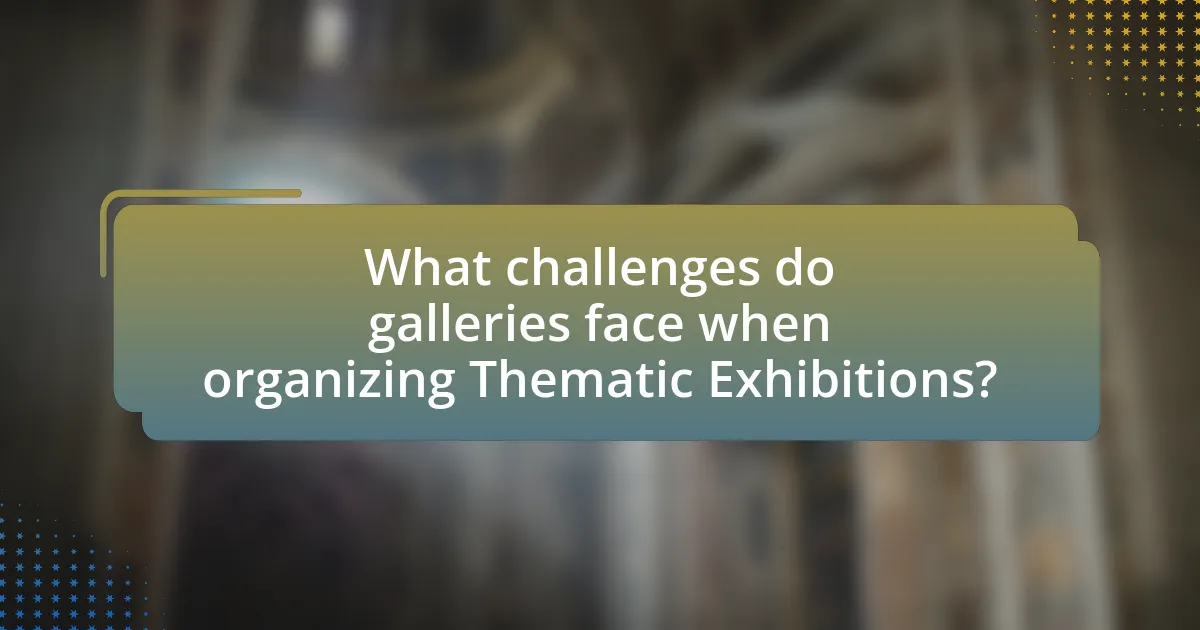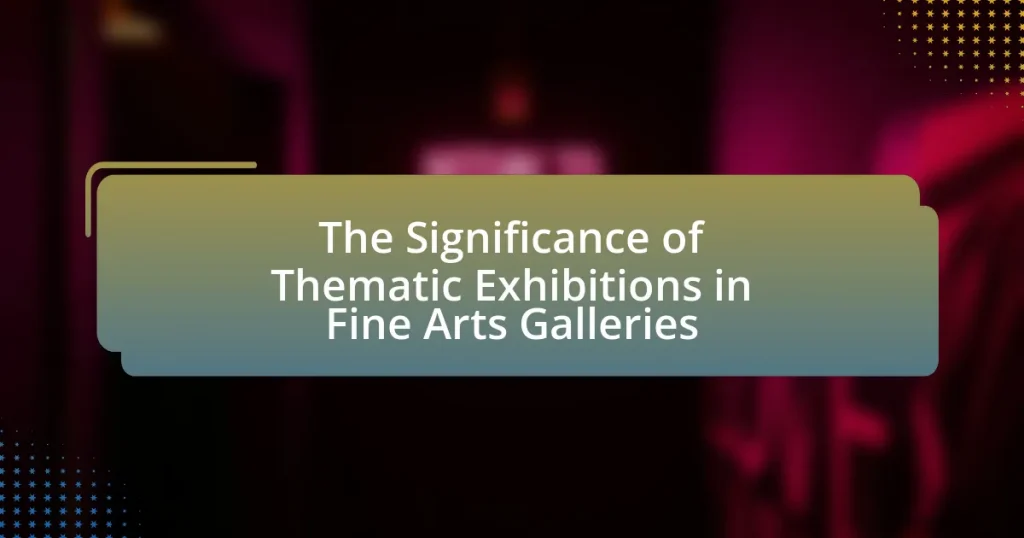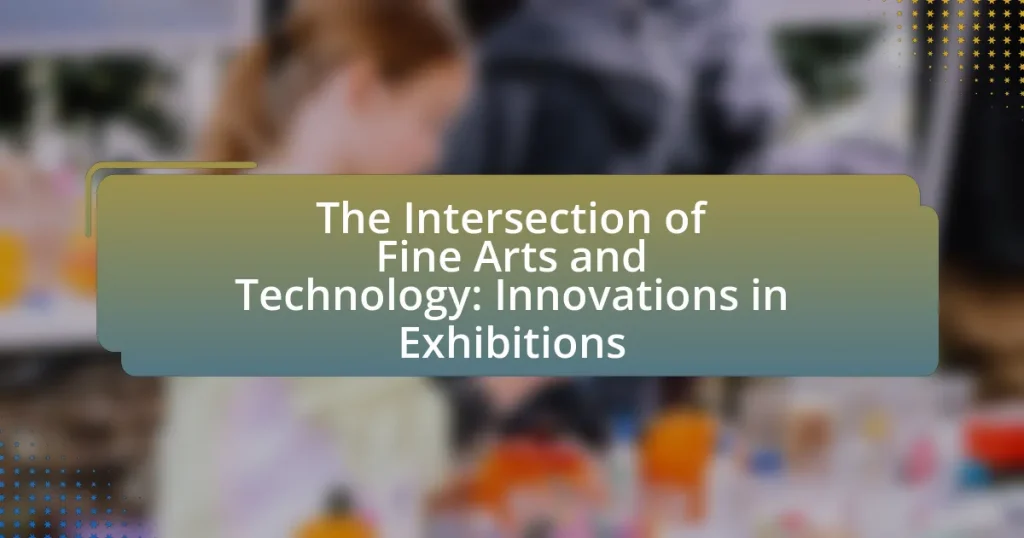Thematic exhibitions in fine arts galleries are curated displays centered around specific themes, concepts, or ideas, showcasing artworks that relate to these central topics. These exhibitions differ from traditional ones by providing a focused narrative that enhances viewer engagement and understanding of cultural, historical, or social contexts. They play a crucial role in promoting artists, reflecting societal issues, and fostering community engagement through immersive experiences. The article explores the defining characteristics, significance, and challenges of thematic exhibitions, as well as their impact on the art market and future trends in gallery practices.

What are Thematic Exhibitions in Fine Arts Galleries?
Thematic exhibitions in fine arts galleries are curated displays that focus on a specific theme, concept, or idea, showcasing artworks that relate to that central topic. These exhibitions allow galleries to explore particular narratives or cultural issues, often bringing together works from various artists and periods to create a cohesive experience. For instance, a thematic exhibition might center on environmental issues, featuring contemporary artists alongside historical pieces that address nature and sustainability. This approach not only enhances the viewer’s understanding of the theme but also encourages dialogue around the subject matter, making the exhibition relevant to current societal discussions.
How do Thematic Exhibitions differ from Traditional Exhibitions?
Thematic exhibitions differ from traditional exhibitions primarily in their focus and organization. Thematic exhibitions center around a specific concept, idea, or theme, allowing for a curated selection of artworks that collectively explore that theme, such as “Identity” or “Nature.” In contrast, traditional exhibitions typically display artworks based on the artist, medium, or chronological order without a unifying theme. This thematic approach enhances viewer engagement by providing context and narrative, making the experience more cohesive and thought-provoking. For instance, the “Van Gogh and Japan” exhibition at the Van Gogh Museum in Amsterdam illustrates how thematic exhibitions can deepen understanding by connecting Van Gogh’s work to Japanese art influences, showcasing the power of thematic curation in enhancing the viewer’s experience.
What are the defining characteristics of Thematic Exhibitions?
The defining characteristics of thematic exhibitions include a focused narrative, curated selection of artworks, and a cohesive visual and conceptual framework. Thematic exhibitions are designed around a specific theme or idea, which guides the selection of artworks and their arrangement, creating a unified experience for the viewer. This approach often emphasizes connections between different pieces, allowing for deeper exploration of the theme. For instance, exhibitions may center on social issues, historical events, or artistic movements, providing context and enhancing the viewer’s understanding. The effectiveness of thematic exhibitions is supported by their ability to engage audiences through storytelling and contextual relevance, making art more accessible and meaningful.
Why are Thematic Exhibitions important for audience engagement?
Thematic exhibitions are important for audience engagement because they create a focused narrative that resonates with viewers, enhancing their emotional and intellectual connection to the artwork. By organizing artworks around a central theme, galleries facilitate deeper exploration of concepts, fostering a more immersive experience. Research indicates that thematic exhibitions can increase visitor retention and satisfaction, as they provide context and coherence, making the art more accessible and relatable. For instance, a study by the American Alliance of Museums found that visitors are more likely to engage with exhibitions that tell a story or explore a specific idea, leading to increased interaction and discussion among audiences.
What purposes do Thematic Exhibitions serve in Fine Arts Galleries?
Thematic exhibitions in fine arts galleries serve to create focused narratives that enhance audience engagement and understanding of specific artistic themes or concepts. By grouping artworks around a central idea, these exhibitions facilitate deeper exploration of cultural, historical, or social contexts, allowing viewers to draw connections between different pieces and the overarching theme. For instance, an exhibition centered on environmental issues may include works that address climate change, prompting discussions about art’s role in activism. This approach not only educates the audience but also fosters a more immersive experience, making art more accessible and relevant to contemporary issues.
How do they enhance the understanding of art?
Thematic exhibitions enhance the understanding of art by providing focused narratives that connect various artworks through a common theme. This approach allows viewers to explore relationships between pieces, fostering deeper insights into artistic intentions and cultural contexts. For example, exhibitions centered on specific movements, such as Impressionism, can illuminate the historical and social factors influencing artists of that time, thereby enriching the viewer’s comprehension of the art. Additionally, thematic exhibitions often include educational materials and guided tours, which further contextualize the artworks and engage audiences in critical discussions about their significance.
What role do they play in promoting artists and their work?
Thematic exhibitions in fine arts galleries play a crucial role in promoting artists and their work by providing a focused platform that highlights specific themes or concepts. These exhibitions curate artworks that resonate with a central idea, allowing artists to showcase their creativity within a contextual framework that engages audiences. For instance, thematic exhibitions can attract diverse audiences, increasing visibility for participating artists and fostering connections with potential buyers and collectors. This targeted approach not only enhances the artists’ reputations but also stimulates discussions around their work, ultimately contributing to their professional growth and market presence.
Why are Thematic Exhibitions significant in the context of cultural discourse?
Thematic exhibitions are significant in the context of cultural discourse because they provide a focused framework for exploring and interpreting specific ideas, themes, or social issues within the arts. By curating artworks around a central concept, these exhibitions facilitate critical dialogue and reflection among diverse audiences, fostering a deeper understanding of cultural narratives. For instance, exhibitions like “The Black Experience” at the Museum of Modern Art have highlighted the contributions and perspectives of African American artists, prompting discussions about race, identity, and representation in contemporary society. This targeted approach not only enhances the visibility of underrepresented voices but also encourages engagement with complex cultural dynamics, making thematic exhibitions a vital tool for cultural discourse.
How do they reflect societal issues and trends?
Thematic exhibitions in fine arts galleries reflect societal issues and trends by showcasing artworks that address contemporary social, political, and cultural themes. These exhibitions often highlight pressing matters such as inequality, climate change, and identity politics, thereby engaging audiences in critical dialogue. For instance, the “Black Lives Matter” movement has inspired numerous exhibitions that explore racial injustice, illustrating how art can serve as a platform for activism and awareness. Additionally, thematic exhibitions frequently respond to current events, such as the COVID-19 pandemic, by presenting works that capture the collective experience of isolation and resilience, thus mirroring the zeitgeist of the time.
What impact do they have on community engagement and education?
Thematic exhibitions in fine arts galleries significantly enhance community engagement and education by providing accessible platforms for cultural exchange and learning. These exhibitions often focus on specific themes that resonate with local communities, fostering a sense of belonging and encouraging participation. For instance, studies have shown that thematic exhibitions can increase visitor numbers by up to 30%, as they attract diverse audiences interested in particular subjects. Additionally, educational programs associated with these exhibitions, such as workshops and guided tours, facilitate deeper understanding and appreciation of the arts, thereby enriching the educational experience for attendees.

How do Thematic Exhibitions influence the art market?
Thematic exhibitions significantly influence the art market by shaping trends, enhancing visibility for artists, and driving sales. These exhibitions curate artworks around specific themes, which can attract diverse audiences and create a focused narrative that resonates with collectors and critics alike. For instance, exhibitions like “The Armory Show” in New York have historically set trends in contemporary art, leading to increased demand for featured artists’ works. Additionally, thematic exhibitions often result in heightened media coverage, which can elevate an artist’s profile and subsequently increase the market value of their pieces. This correlation between thematic exhibitions and market dynamics is evidenced by the rise in auction prices for artists showcased in prominent thematic exhibitions, demonstrating their direct impact on the art market.
What effects do they have on art sales and artist visibility?
Thematic exhibitions significantly enhance art sales and artist visibility by creating focused narratives that attract targeted audiences. These exhibitions often draw attention to specific themes or concepts, making the artwork more relatable and engaging for potential buyers. For instance, a thematic exhibition centered on environmental issues can resonate with eco-conscious collectors, leading to increased sales. Additionally, thematic exhibitions often receive more media coverage and marketing support, which amplifies the visibility of participating artists. According to a study by the National Endowment for the Arts, exhibitions that highlight specific themes can increase attendance by up to 30%, directly correlating with higher sales figures and greater exposure for artists involved.
How can Thematic Exhibitions drive interest in specific art movements?
Thematic exhibitions can drive interest in specific art movements by curating artworks that highlight the defining characteristics and historical context of those movements. By presenting a focused narrative, these exhibitions engage audiences through immersive experiences that educate them about the significance and evolution of the art form. For instance, a thematic exhibition on Impressionism can showcase key works by artists like Claude Monet and Edgar Degas, allowing visitors to appreciate the movement’s emphasis on light and color. This targeted approach not only attracts art enthusiasts but also draws in new audiences, as evidenced by increased attendance figures reported in galleries that host such exhibitions.
What are the financial implications for galleries hosting these exhibitions?
Galleries hosting thematic exhibitions face significant financial implications, including potential revenue generation and increased operational costs. Revenue can be derived from ticket sales, merchandise, and increased foot traffic leading to higher sales of artworks. For instance, a study by the National Endowment for the Arts found that exhibitions can boost attendance by up to 30%, directly impacting sales. However, galleries also incur costs related to marketing, installation, and insurance for the artworks, which can range from thousands to tens of thousands of dollars depending on the scale of the exhibition. Thus, while thematic exhibitions can enhance financial performance, they require careful financial planning to balance potential profits against incurred expenses.
How do Thematic Exhibitions contribute to the reputation of Fine Arts Galleries?
Thematic exhibitions enhance the reputation of fine arts galleries by showcasing curated collections that reflect specific concepts or cultural narratives. These exhibitions attract diverse audiences, including art critics, collectors, and the general public, thereby increasing visibility and engagement. For instance, a thematic exhibition focused on contemporary social issues can position a gallery as a thought leader in the art community, fostering discussions that resonate beyond the art itself. Furthermore, galleries that host innovative thematic exhibitions often receive media coverage, which amplifies their recognition and prestige within the art world. This strategic approach not only elevates the gallery’s profile but also establishes it as a destination for meaningful artistic experiences.
What strategies can galleries use to curate successful Thematic Exhibitions?
Galleries can curate successful thematic exhibitions by establishing a clear and engaging theme that resonates with their audience. This involves conducting thorough research to identify relevant topics that reflect current trends or historical significance, ensuring the theme is both timely and meaningful. For instance, the Museum of Modern Art in New York has successfully curated exhibitions around themes like “The Future of Work” to engage contemporary discussions. Additionally, galleries should select artworks that cohesively align with the theme, creating a narrative that guides visitors through the exhibition. Collaborating with artists and experts can enhance the depth of the exhibition, as seen in the Tate Modern’s thematic shows that often include artist talks and panel discussions. Effective marketing strategies, including social media campaigns and partnerships with local organizations, can also increase visibility and attendance, as demonstrated by the success of the “Frida Kahlo: Appearances Can Be Deceiving” exhibition at the V&A Museum, which attracted record crowds through targeted outreach.
How do visitor experiences shape the gallery’s brand identity?
Visitor experiences significantly shape a gallery’s brand identity by influencing perceptions and emotional connections. Positive interactions, such as engaging exhibitions and knowledgeable staff, enhance visitor satisfaction, leading to favorable word-of-mouth and repeat visits. For instance, galleries that curate thematic exhibitions that resonate with audiences often see increased visitor engagement, which reinforces their brand as innovative and culturally relevant. Research indicates that 70% of visitors are more likely to recommend a gallery after a positive experience, highlighting the direct correlation between visitor satisfaction and brand loyalty.

What challenges do galleries face when organizing Thematic Exhibitions?
Galleries face several challenges when organizing thematic exhibitions, including curatorial coherence, funding limitations, and audience engagement. Curatorial coherence requires a clear and compelling narrative that connects the artworks, which can be difficult to achieve, especially with diverse artists and styles. Funding limitations often restrict the scope of exhibitions, as galleries must secure financial support for logistics, marketing, and installation costs. Additionally, engaging the audience poses a challenge; galleries must create programming and outreach strategies that attract visitors and foster meaningful interactions with the art. These challenges are significant as they directly impact the success and educational value of the exhibitions.
What logistical considerations must be addressed?
Logistical considerations that must be addressed in thematic exhibitions in fine arts galleries include space allocation, transportation of artworks, installation requirements, and visitor flow management. Space allocation involves determining the appropriate layout to enhance the thematic narrative while ensuring accessibility. Transportation of artworks requires careful planning to prevent damage, often necessitating specialized packing and climate-controlled transport. Installation requirements include the need for proper lighting, security measures, and display techniques that align with the exhibition’s theme. Visitor flow management is crucial to ensure a positive experience, which may involve designing pathways and signage to guide attendees effectively. These considerations are essential for the successful execution of thematic exhibitions, as they directly impact the presentation and reception of the artworks.
How can galleries effectively manage exhibition budgets?
Galleries can effectively manage exhibition budgets by implementing detailed financial planning and monitoring throughout the exhibition process. This involves creating a comprehensive budget that outlines all potential expenses, including venue costs, marketing, installation, and artist fees. Regularly tracking actual expenditures against the budget allows galleries to identify discrepancies early and make necessary adjustments. For instance, a study by the National Endowment for the Arts found that organizations that maintain strict budget oversight are 30% more likely to stay within their financial limits. Additionally, seeking sponsorships and partnerships can provide additional funding sources, further alleviating budget constraints.
What are the common pitfalls in curating Thematic Exhibitions?
Common pitfalls in curating thematic exhibitions include a lack of clear focus, inadequate audience engagement, and insufficient research on the theme. A lack of clear focus can lead to a disjointed narrative, making it difficult for visitors to understand the exhibition’s purpose. Inadequate audience engagement often results in a failure to connect with the target demographic, diminishing the exhibition’s impact. Insufficient research on the theme can lead to inaccuracies or superficial interpretations, undermining the exhibition’s credibility. These pitfalls can detract from the overall effectiveness and educational value of the exhibition.
How can galleries overcome these challenges?
Galleries can overcome challenges by implementing strategic marketing and community engagement initiatives. By utilizing social media platforms and targeted advertising, galleries can reach wider audiences and attract diverse visitors. For instance, a study by the National Endowment for the Arts found that effective marketing can increase attendance by up to 30%. Additionally, collaborating with local artists and organizations fosters community ties, enhancing visitor interest and participation. This approach not only addresses attendance issues but also enriches the thematic exhibitions by incorporating local narratives and perspectives, thereby creating a more inclusive and engaging experience for all visitors.
What best practices should be followed for successful execution?
Successful execution of thematic exhibitions in fine arts galleries requires clear objectives, effective planning, and audience engagement. Establishing clear objectives ensures that the exhibition aligns with the gallery’s mission and resonates with the target audience. Effective planning involves meticulous organization of logistics, including artwork selection, installation, and marketing strategies. Engaging the audience through interactive elements, educational programs, and community involvement enhances the overall experience and fosters a deeper connection with the art. Research indicates that galleries that prioritize audience engagement see increased visitor satisfaction and attendance, reinforcing the importance of these best practices.
How can collaboration with artists enhance the exhibition experience?
Collaboration with artists enhances the exhibition experience by integrating diverse perspectives and creative expressions that engage audiences more deeply. When artists contribute their unique insights and techniques, they create immersive environments that resonate emotionally with viewers, fostering a stronger connection to the artwork. For instance, exhibitions that feature live art creation or artist-led workshops have been shown to increase visitor interaction and satisfaction, as evidenced by studies indicating that participatory art experiences can elevate audience engagement by up to 40%. This collaborative approach not only enriches the thematic narrative of the exhibition but also encourages dialogue between artists and the public, making the experience more dynamic and memorable.
What are the future trends for Thematic Exhibitions in Fine Arts Galleries?
Future trends for thematic exhibitions in fine arts galleries include increased integration of technology, a focus on social issues, and enhanced visitor engagement. Galleries are adopting virtual and augmented reality to create immersive experiences, allowing audiences to interact with art in innovative ways. Additionally, thematic exhibitions are increasingly addressing contemporary social issues, such as climate change and social justice, reflecting the evolving cultural landscape. This shift is supported by data indicating that 70% of visitors prefer exhibitions that engage with current societal themes. Furthermore, galleries are prioritizing interactive elements, such as workshops and discussions, to foster deeper connections between artists and audiences, enhancing the overall experience and relevance of thematic exhibitions.
How is technology shaping the presentation of Thematic Exhibitions?
Technology is significantly shaping the presentation of thematic exhibitions by enhancing interactivity and accessibility. Digital tools such as augmented reality (AR) and virtual reality (VR) allow visitors to engage with artworks in immersive ways, creating a more dynamic experience. For instance, the use of AR can overlay additional information or animations onto physical artworks, enriching the viewer’s understanding and appreciation. Furthermore, technology facilitates remote access to exhibitions through virtual tours, enabling a broader audience to experience the thematic content without geographical limitations. This shift is supported by data indicating that galleries utilizing digital platforms have seen increased visitor engagement and satisfaction, demonstrating the effectiveness of technology in modern exhibition practices.
What emerging themes are likely to dominate future exhibitions?
Emerging themes likely to dominate future exhibitions include sustainability, technology integration, and social justice. Sustainability is increasingly prioritized as galleries aim to address climate change and promote eco-friendly practices, evidenced by the rise of exhibitions focused on environmental art and materials. Technology integration is also significant, with virtual reality and augmented reality becoming common tools for enhancing visitor engagement and experience. Additionally, social justice themes are gaining traction, as artists and curators highlight issues such as racial inequality and gender representation, reflecting broader societal movements. These themes are supported by trends in audience interest and the evolving role of galleries in contemporary discourse.
What practical tips can galleries implement for successful Thematic Exhibitions?
Galleries can implement several practical tips for successful thematic exhibitions, including defining a clear theme, curating relevant artworks, and engaging the audience through interactive elements. A well-defined theme provides a cohesive narrative that guides the selection of artworks, ensuring they resonate with the central concept. Curating relevant artworks involves selecting pieces that not only fit the theme but also complement each other, enhancing the overall experience. Engaging the audience can be achieved through interactive elements such as guided tours, workshops, or digital media that encourage participation and deeper understanding. These strategies have been shown to increase visitor engagement and satisfaction, ultimately leading to a more successful exhibition.












